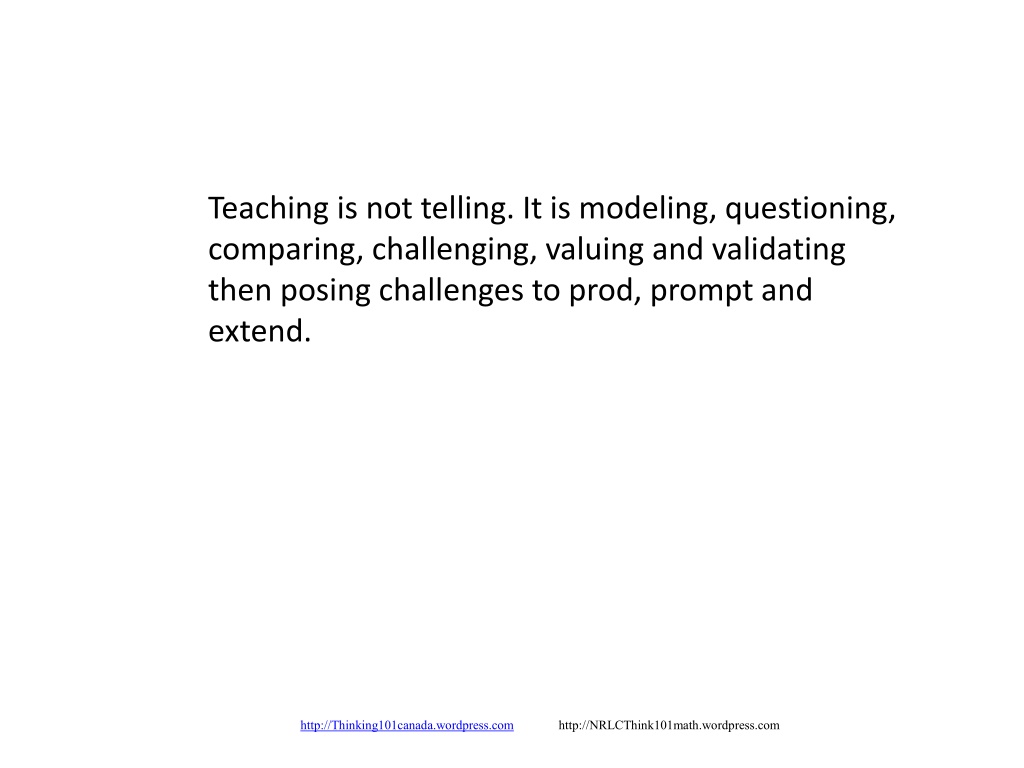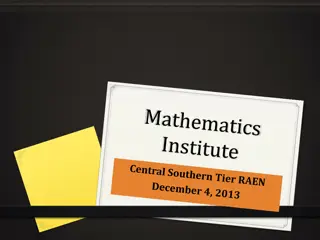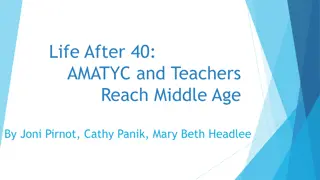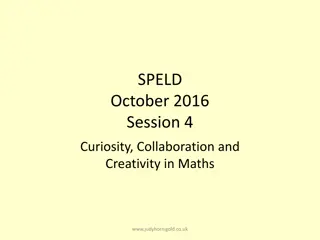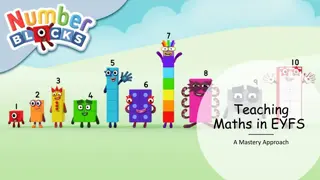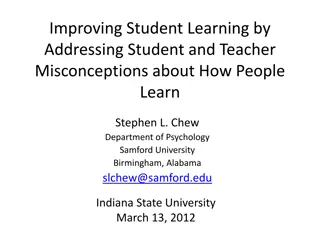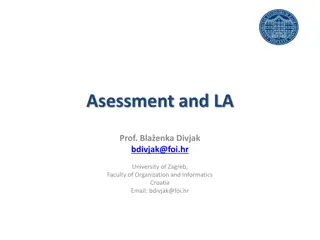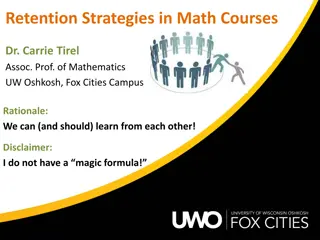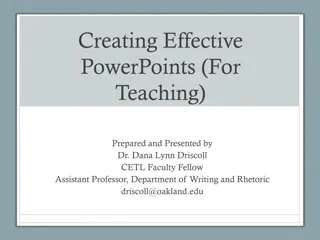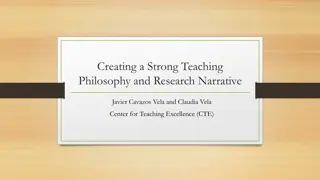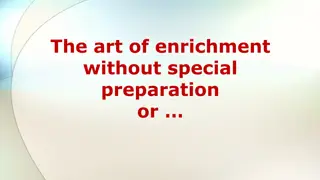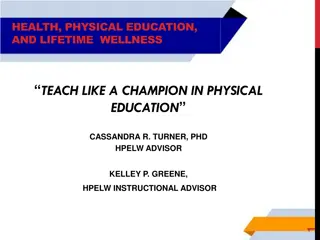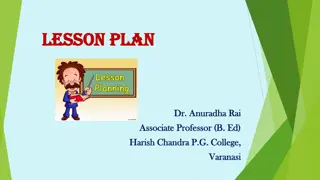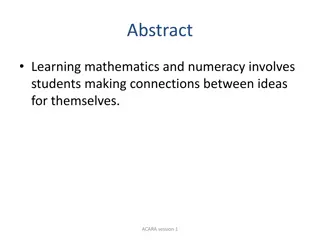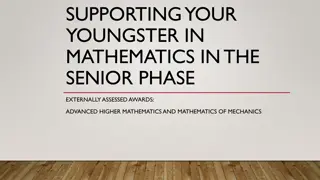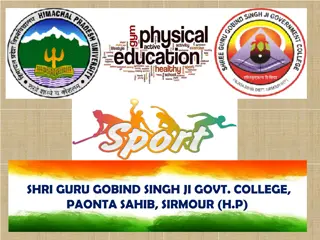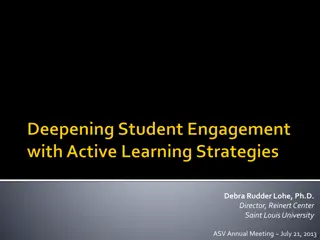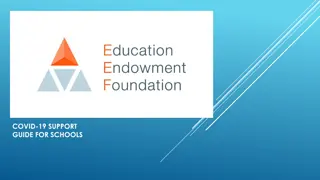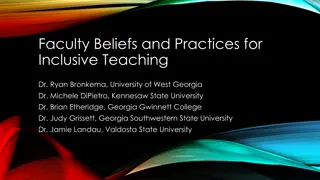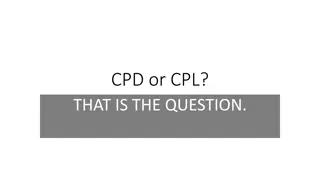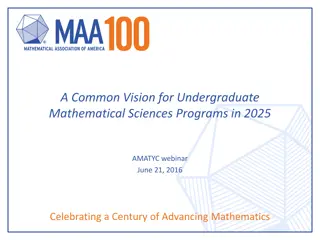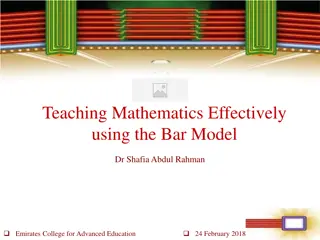Effective Teaching Strategies for Mathematics Learning
Effective teaching involves more than just telling information; it requires modeling, questioning, comparing, challenging, valuing, and validating students' ways of thinking. By understanding students' perspectives and utilizing visual-spatial techniques, educators can help students make connections, recognize patterns, and develop critical thinking skills in mathematics. Incorporating strategies that emphasize embedded relationships in numbers and shapes can enhance students' understanding of concepts like fractions and decimals. Lastly, fostering logical yet flexible thinking in students encourages them to explore multiple approaches and perspectives in problem-solving.
- Effective teaching
- Mathematics learning
- Visual-spatial techniques
- Critical thinking skills
- Embedded relationships
Uploaded on Oct 01, 2024 | 0 Views
Download Presentation

Please find below an Image/Link to download the presentation.
The content on the website is provided AS IS for your information and personal use only. It may not be sold, licensed, or shared on other websites without obtaining consent from the author. Download presentation by click this link. If you encounter any issues during the download, it is possible that the publisher has removed the file from their server.
E N D
Presentation Transcript
Teaching is not telling. It is modeling, questioning, comparing, challenging, valuing and validating then posing challenges to prod, prompt and extend. http://Thinking101canada.wordpress.com http://Thinking101canada.wordpress.com http://NRLCThink101math.wordpress.com
It is our professional responsibility to make every effort to understand students ways of thinking and coming to know. Working from what they know we must provide specific focused feedback and carefully constructed lessons to provide opportunities for students to link their ways of thinking and knowing to the symbol system we want them to learn. We lose students when we start from the symbol system and try to work back to understanding. Seeing and understanding comes before a2 + b2 = c2 http://Thinking101canada.wordpress.com http://Thinking101canada.wordpress.com http://NRLCThink101math.wordpress.com
Strong Visual spatial learners bring several natural advantages to the learning of mathematics: they connect the pieces to recognize whole concepts quickly they see links between pieces and tie them into webs of connections they find patterns easily they think graphically and understand dimensionality. Glorway@telusplanet.net 2009 Thinking 101 http://Thinking101canada.wordpress.com http://Thinking101canada.wordpress.com http://NRLCThink101math.wordpress.com
http://Thinking101canada.wordpress.com http://Thinking101canada.wordpress.com http://NRLCThink101math.wordpress.com
Number is in Number and Shape is in Shape.. Two, three, five and ten are numbers we look for inside other numbers. This is how strategies for adding and subtracting emerge. Fractions are inside fractions . That is how we come to know equivalent fractions. Decimals are inside other decimals. Shapes are inside other shapes... A huge idea in mathematics is to see the embedded relationships. http://Thinking101canada.wordpress.com http://Thinking101canada.wordpress.com http://NRLCThink101math.wordpress.com
Critical Thinkers are logical but flexible in their thinking. Flexible thinkers accept multiple approaches and multiple perspectives. Logical thinkers seek out the order, what common in all these ways... How do they connect. http://Thinking101canada.wordpress.com http://Thinking101canada.wordpress.com http://NRLCThink101math.wordpress.com
Students describe what they saw and how they thought to draw it. Teachers encourage and model appropriate vocabulary.... Encourage students to see 3D as well. How does that change the description? http://Thinking101canada.wordpress.com http://Thinking101canada.wordpress.com http://NRLCThink101math.wordpress.com
Quickdraw works on flexible thinking. We all can describe what we see different ways but we all see the same things once we discuss. Moving things in space allows you to really describe and understand their properties.. What changed? What stayed the same when you moved it or changed your perspective? http://Thinking101canada.wordpress.com http://Thinking101canada.wordpress.com http://NRLCThink101math.wordpress.com
Quickdraw works on developing vocabulary and practicing with it until you really understand it. The teacher does not give definitions to memorize. We discuss properties of shapes until we are sure we have the most concise way to explain the attributes that make it this and not that. http://Thinking101canada.wordpress.com http://Thinking101canada.wordpress.com http://NRLCThink101math.wordpress.com
This kind of mental fluency affects all areas of learning. Look, think, then draw what you saw. http://Thinking101canada.wordpress.com http://Thinking101canada.wordpress.com http://NRLCThink101math.wordpress.com
The draw time is to give your brain a chance to really think about what it saw... Use pens, markers, fingers in the air, fingers on a surface to draw if you find the drawing is stopping students from engaging. It is not a drawing contest. http://Thinking101canada.wordpress.com http://Thinking101canada.wordpress.com http://NRLCThink101math.wordpress.com
Talk about what you saw and how you thought about it is critical. Sometimes just have students tell a partner. http://Thinking101canada.wordpress.com http://Thinking101canada.wordpress.com http://NRLCThink101math.wordpress.com
Compare what you saw, how you described it, how you tried to draw it with others. The comparing is where the learning happens. http://Thinking101canada.wordpress.com http://Thinking101canada.wordpress.com http://NRLCThink101math.wordpress.com
Build vocabulary lists to make the descriptions more mathematical over time. http://Thinking101canada.wordpress.com http://Thinking101canada.wordpress.com http://NRLCThink101math.wordpress.com
B. E. R. C. S. http://Thinking101canada.wordpress.com http://Thinking101canada.wordpress.com http://NRLCThink101math.wordpress.com
Think 2 dimensional and 3 dimensional. If you trace the shape it is 2D. If you describe an object moving off or out of the page, it is 3D. http://Thinking101canada.wordpress.com http://Thinking101canada.wordpress.com http://NRLCThink101math.wordpress.com
I show the image for 3 seconds, give you time to do first draw. I show again, 3 seconds. Give you time to draw again. I show again, 3 seconds, really look. Do you see something a new way? http://Thinking101canada.wordpress.com http://Thinking101canada.wordpress.com http://NRLCThink101math.wordpress.com
The Heres What I saw slides are for the teacher, not meant to show students. http://Thinking101canada.wordpress.com http://Thinking101canada.wordpress.com http://NRLCThink101math.wordpress.com
http://Thinking101canada.wordpress.com http://Thinking101canada.wordpress.com http://NRLCThink101math.wordpress.com
Ready? http://Thinking101canada.wordpress.com http://Thinking101canada.wordpress.com http://NRLCThink101math.wordpress.com
http://Thinking101canada.wordpress.com http://Thinking101canada.wordpress.com http://NRLCThink101math.wordpress.com
http://Thinking101canada.wordpress.com http://Thinking101canada.wordpress.com http://NRLCThink101math.wordpress.com
http://Thinking101canada.wordpress.com http://Thinking101canada.wordpress.com http://NRLCThink101math.wordpress.com
http://Thinking101canada.wordpress.com http://Thinking101canada.wordpress.com http://NRLCThink101math.wordpress.com
http://Thinking101canada.wordpress.com http://Thinking101canada.wordpress.com http://NRLCThink101math.wordpress.com
Class Discussion I leave the image up to discuss it... Otherwise students change their minds. http://Thinking101canada.wordpress.com http://Thinking101canada.wordpress.com http://NRLCThink101math.wordpress.com
I saw a square and broke it in parts. I saw a triangle and then added to it. I thought of an envelope. Are the triangles congruent? Are they iscoceles, equilateral, scalene? Right angles, obtuse, acute, reflex? Do the outside triangles fold in to make the centre triangle? Reflect, rotate, translate? A trapezoid. Four sides, one set parallel. Quadrilaterals, rectangles, squares how are they related? How would you prove a square? Not a square? Some things I saw Angles: 90 degree, 45 degree? 180 degree? How would you prove? Acute obtuse http://Thinking101canada.wordpress.com http://Thinking101canada.wordpress.com http://NRLCThink101math.wordpress.com
Ready? http://Thinking101canada.wordpress.com http://Thinking101canada.wordpress.com http://NRLCThink101math.wordpress.com
http://Thinking101canada.wordpress.com http://Thinking101canada.wordpress.com http://NRLCThink101math.wordpress.com
http://Thinking101canada.wordpress.com http://Thinking101canada.wordpress.com http://NRLCThink101math.wordpress.com
http://Thinking101canada.wordpress.com http://Thinking101canada.wordpress.com http://NRLCThink101math.wordpress.com
http://Thinking101canada.wordpress.com http://Thinking101canada.wordpress.com http://NRLCThink101math.wordpress.com
http://Thinking101canada.wordpress.com http://Thinking101canada.wordpress.com http://NRLCThink101math.wordpress.com
http://Thinking101canada.wordpress.com http://Thinking101canada.wordpress.com http://NRLCThink101math.wordpress.com
I saw 3 triangles. Two are congruent. A see five sided shape. An irregular pentagon. Are the triangles isoceles? Scalene? Acute? What kinds of angles can you identify? If I lift the overlapped triangle up, this is a huge triangle folded. If I move the overlapped triangle over, it is laying over a trapezoid. Some things I saw I see a 7 sided shape. Seven sides is a heptagon or septagon. It is irregular http://Thinking101canada.wordpress.com http://Thinking101canada.wordpress.com http://NRLCThink101math.wordpress.com
Compare the two images. How the same, how different. Use paper to fold into these two different shapes. http://Thinking101canada.wordpress.com http://Thinking101canada.wordpress.com http://NRLCThink101math.wordpress.com
Ready? http://Thinking101canada.wordpress.com http://Thinking101canada.wordpress.com http://NRLCThink101math.wordpress.com
http://Thinking101canada.wordpress.com http://Thinking101canada.wordpress.com http://NRLCThink101math.wordpress.com
http://Thinking101canada.wordpress.com http://Thinking101canada.wordpress.com http://NRLCThink101math.wordpress.com
http://Thinking101canada.wordpress.com http://Thinking101canada.wordpress.com http://NRLCThink101math.wordpress.com
http://Thinking101canada.wordpress.com http://Thinking101canada.wordpress.com http://NRLCThink101math.wordpress.com
http://Thinking101canada.wordpress.com http://Thinking101canada.wordpress.com http://NRLCThink101math.wordpress.com
http://Thinking101canada.wordpress.com http://Thinking101canada.wordpress.com http://NRLCThink101math.wordpress.com
The outside shape is a rhombus. That is the math word for diamond. It has 2 acute and 2 obtuse angles. It has adjacent sides equal length. It has 4 sides so it is a quadrilateral. It has parallel sides so it is a parallelogram If you want to get technical it is also called a kite. Are these equilateral triangles. If not what? Are there 90 degree angles. Where are they. What is an interior angle, what is an exterior angle? What other angles can you estimate without a protractor? How? Some things I saw What happens if you stretch or shrink the sides. Do you see congruence? Symmetry? I can trace at least 2 pentagons. They are irregular. http://Thinking101canada.wordpress.com http://Thinking101canada.wordpress.com http://NRLCThink101math.wordpress.com
Ready? http://Thinking101canada.wordpress.com http://Thinking101canada.wordpress.com http://NRLCThink101math.wordpress.com
http://Thinking101canada.wordpress.com http://Thinking101canada.wordpress.com http://NRLCThink101math.wordpress.com
http://Thinking101canada.wordpress.com http://Thinking101canada.wordpress.com http://NRLCThink101math.wordpress.com
http://Thinking101canada.wordpress.com http://Thinking101canada.wordpress.com http://NRLCThink101math.wordpress.com
http://Thinking101canada.wordpress.com http://Thinking101canada.wordpress.com http://NRLCThink101math.wordpress.com
http://Thinking101canada.wordpress.com http://Thinking101canada.wordpress.com http://NRLCThink101math.wordpress.com
